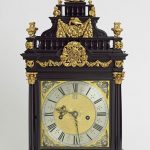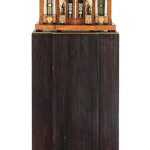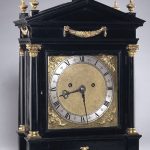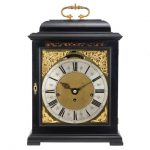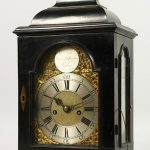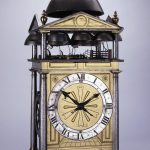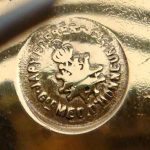Ebony Clocks. Ebony is a dense black/brown hardwood, most commonly yielded by several different species in the genus Diospyros, which also contains the persimmons. Ebony is dense enough to sink in water. It is finely-textured and has a very smooth finish when polished, making it valuable as an ornamental wood. The word ebony comes from the Ancient Egyptian hbny, through the Ancient Greek ἔβενος (ébenos), into Latin and Middle English. Reference: Wikipedia
A large bracket clock in solid oak and veneered in ebony decorated with gilt brass mounts and surmounted by a figure of Cupid standing on the back of a dolphin. The clock is architectural in form with two tiers of balustrading and is decorated on all four sides. Above the clock face is a cartouche enclosing a royal cypher.
Decorative scheme The rectangular clock case, glazed on all four sides, is articulated by four Corinthian columns with gilt brass capitals and bases, outset at the corners, and stands on a plain rectangular plinth raised on four ball feet. The dial has an engraved rose in the centre, a silvered dial ring and silver winged cherubs in the spandrels. The lacquered brass back plate of the clock movement is finely engraved with tulips arising from a Neoclassical urn.
The clock has an elaborate superstructure comprising four tiers of finely cast gilt-brass mounts set against an ebony background, surmounted by a cast bronze or brass group of a naked and winged Cupid, blindfolded and holding a bow in his outstretched arm, standing on the back of stylised dolphin. The columns are surmounted by an entablature comprising a small cornice, a frieze, and a larger arched cornice, each cornice with outset corners. The frieze is decorated with gilt-brass swags of fruit, and with a small swagged lion mask at each end, above the columns. On the front and back of the clock, the swags are centred on a circular medallion, which is enclosed in a laurel wreath, supported by cherubs, with an acanthus cresting, a mask below and swags of fruit and leaves on either side. Within the cartouche is a royal cipher which appears to relate to King George I, but which is evidently a later addition of uncertain date. The entablature is surmounted by a balustrade, framed by outset plinths at the corners and moulded rails above and below. The outer faces of the plinths have applied gilt-brass grotesque masks, possibly ‘green men’ with horns, pointed ears and sprouting leaves. Each plinth supports an urn decorated with leaves and flowers and surmounted by a leaf finial. Behind the balustrade is a platform with voluted sides, and with a gilt-brass relief on the front and back faces comprising a swag of leaves and fruit, with pears, grapes and a central pomegranate. A bird stands on the top of the swag pecking at a piece of fruit. This platform supports a second, smaller plinth, enclosed by a second, narrower balustrade formed of turned ebony balusters, the small corner plinths embellished with winged cherubs and supporting leaf finials. On the plinth stands the figurative group.
The impact of this impressive clock is made by the towering architectural cresting embellished with extremely fine gilt-brass mounts, and surmounted by a cast and gilt figure of Cupid riding on a stylised dolpin and firing his bow. The brightness of the gilding contrasts with the black, ebony-veneered structure of the clock case. Only a few clocks and watches known are known to be made by the clockmaker Jeremie (sometimes spelt Jeremiah) Gregory, who was trained as a goldsmith. He was Master of the Worshipful Company of Clockmakers for four years. This clock is said to have been acquired by the Royal Collection during the reign of George I, and it seems likely that at that time, several of the mounts were replaced and added. The cipher above the clock face reads: ‘GEO:REX:D:G:A’. MEANING ‘George, by the Grace of God, King of England’.
Reference: © Victoria and Albert Museum
A unique first quarter of the 19th century Austrian ormolu, ebony and alabaster-mounted burr thuya wood automata organ clock J. Ad. Hoyer, Wien. The architectural case set with ormolu mounts and balustrades, the niches supported on alabaster columns, centred by a pair of a doors flanked by parcel gilt standing female caryatids, on a bow-fronted base, the 5.25 inch gilt dial centred by the white enamel Arabic dial with concentric date and moon hands, the gilt surround set with a pair of standing warriors, each with a raised arm moving in tandem with the gong-striking movement to sound the hours and quarters, the clock movement with circular plates cast with a wedge-shaped base, silk suspension striking the hours and the quarters on a pair of blued steel coiled gongs, activating the musical organ below playing a choice of seven melodies on twenty four wooden pipes. The 12 inch wooden pinned barrel powered by the large single gut fusee movement signed in full in copperplate script,’J. Ad. Hoyer, Wien’ wound from the right hand side door on the hour to strike the bell. An applied hand-written label on the barrel gives the following tune titles: 1. Ouverture aus Italiana in Algeri (Rossini 1813) 2. Polonaise di Rohsini 3. Schlussgesang aus der Elster (Rossini 1817) 4. Pas de deux aus Alfred (Gallenburg 1820) 5. Variationen/ Es ist alles eins 6. Ober und Unter Osterreicher 7. Marsch aus Alfred (Gallenberg 1820) height 53cm; width 55cm; depth 32cm
Sold for £ 28,812 inc. premium at Bonham’s in 2019
Table clock; eight-day spring-driven movement with fusees; verge escapement and short bob pendulum; going-train incorporates a true centre-wheel which revolves once per hour and carries the minute hand on a smaller wheel; striking-train with count-wheel (for hours only); plain back plate; ebony veneered case with a drawer; gilded brass mounts; frame constructed with pillars riveted to back plate, front plate secured with latches. TRAIN-COUNTS. Going. Gt wheel: 96 Centre wheel: 84/7 Contrate wheel: 72/6 Crown wheel: 27/6 Fusee ratchet 24, set-up ratchet 16. Motion-work. Canon pinion: 48 Minute wheel: 48 Minute pinion: 6 Hour wheel: 72 Gt wheel: 80 Pin wheel: 72/10 (with 12 lifting pins). Hoop wheel: 48/6 Warning wheel: 48/6 Fly: 6 Count wheel: 52 Pin pinion: 8 Fusee ratchet: 27 Set-up ratchet:16
KOLOMAN MOSER (1868-1918) Rare Mantel Clock, model no. S 771, 1907-1908 executed by Alfred Mayer at the Wiener Werkstätte, Austria ebony, partially engraved and gold painted colored glass, silver, clear glass 9¾ in. (24.8 cm) high; 12¼ in. (31.1 cm) wide; 4¾ in. (12.1 cm) deep side stamped with Diana assay mark, rose mark, WW, artist’s monogram KM and maker’s mark AM
Sold for USD 411,000 at Christie’s in 2019
English Ebony Veneered Bracket Clock Samuel Watson, late 17th century With three-train, six-pillar rack and snail quarter striking fusee verge escapement, false pendulum, strike/silent lever, the 9 1/4 x 10 1/4 dial with matted center and 8 15/16 chapter ring, the upper spandrels with putti supporting female masks, the lower spandrels with winged cherubs, the profusely engraved backplate with scrolls within a wheat sheaf border, signed Sam Watson/Londini fecit, the pierced apron chased and cast with a mask. Height 18 inches (45.7 cm), width 13 inches (33.1 cm), depth 71/4 inches (18.5 cm)
Sold for $31,250 (includes buyer’s premium) at Doyle New York in 2016
A SUPERB BRACKET CLOCK by SIMON DE CHARMERS, LONDON, in an ebony case with brass carrying handle, glass sides and door, with circular chapter ring, fusee movement, striking on a single bell with signed back plate, repeat pull action. 15.5ins high x 9ins wide.
Sold for £3,000 at John Nicholson Auctioneers in 2019
